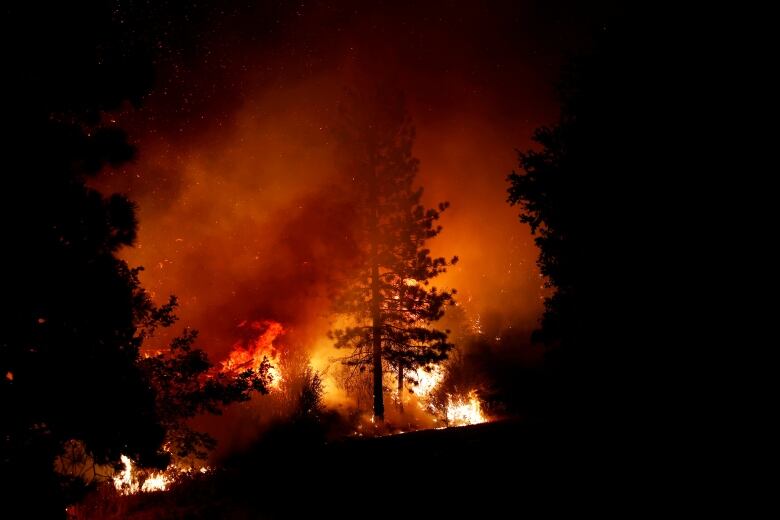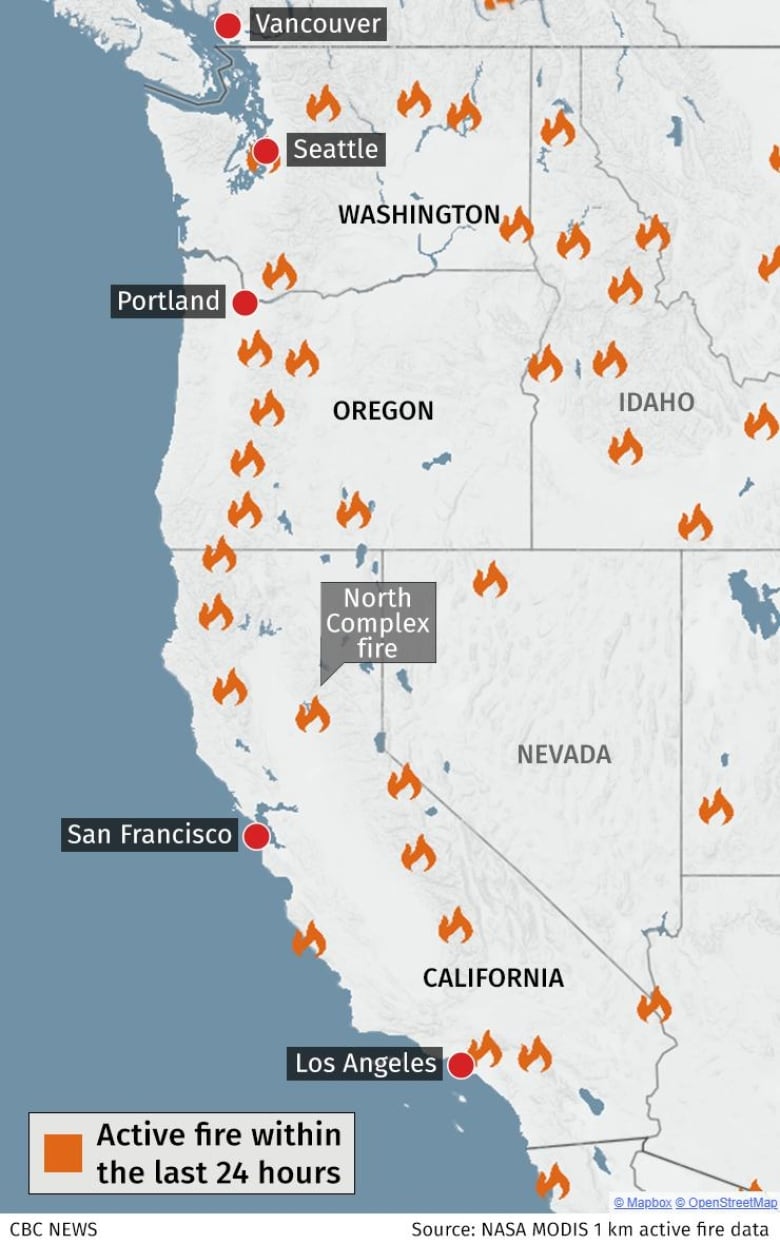What's behind the 'unprecedented' wildfires ravaging California
More evidence of climate change role in extreme fires in Western Canada and U.S.
Monstrous wildfires tearing through California have so far killed at least a dozen people, destroyed some 4,000 structures and burned more than 12,500 square kilometres (more than double the area of Prince Edward Island), breaking records as the worst fire season in the state's history.
"This is an unprecedented event," said Noah Diffenbaugh, professor and senior fellow at Stanford University in California, who has been studying fire risk in California. "We now have the largest wildfire in the state's history, as well as the third largest and the fourth largest and five of the Top 10."
He said they've all started in the past three and a half weeks. The North Complex Firein northern California, which broke out on Aug. 17 following lightning strikes, has become the largest wildfire in state history.
So what's behind this disaster?
Diffenbaugh said there are multiple contributors behind any individual fire, including ignition from lightning or humans and the availability of dry fuel to feed the flames.
But research over the past 15 years shows that climate change has drastically amplified the risk of many conditions that help wildfires ignite and spread.
"We now have very strong evidence from those years of research that global warming is, in fact, increasing the odds of unprecedented extremes," Diffenbaugh said.

In astudy published in the journal Environmental Research Letters in August, Diffenbaugh and his colleagues reported that the number of days with high fire risk in California have doubled since the early 1980s, as climate change increased average temperatures by about 1 C and autumn precipitation declined by 30 per cent. Higher temperatures lead to earlier snowmelt, a longer fire seasonand drier vegetation, especially by August and September.
That higher risk has contributed to a tenfold increase in the area burned in the western part of the United States over the past four decades, Diffenbaugh said.
WATCH | Scientist says climate change contributes to scale,intensity of wildfires:
Not only are fires more frequent, but they're growing more quickly, he said.
"The brave men and women on the ground who are fighting these fires are describing a rate of spread that is unprecedented in their years of experience," he said, noting that the record-breaking North Complex Fire ripped across 32 kilometres in one night.
WATCH | Wildfires devastateportions of western United States:
The research also suggests that this year's new records will soon be broken by even more extreme wildfire seasons.
"If global warming continues along its current trajectory, we're very likely to experience dramatic intensification doubling, even tripling of the frequency of occurrence of these extreme wildfire weather conditions," Diffenbaugh said.
Western Canada faces fiery future, too
Those conditions are not unique to California, as devastating wildfires are also burning inOregon and Washington state.
"We have quite a bit of evidence that this global warming is increasing the risk not only in California and the western United States, but also in Western Canada," Diffenbaugh said.
Western Canada has had a slow wildfire season so far this year after some record seasons in recent years, including one whose destructiveness has been directly linked to climate change.
However, after more than 70 wildfires broke out in southern B.C. over two days in August, officials warned that sustained hot, dry weather could lead to more, and fire bans were imposed across a wide swath of Alberta.

Simon Donner, a climate scientist and professor of geography at the University of British Columbia in Vancouver, noted that, in fact, Canada is warming at about double the world's average rate. "And so that means more extreme heat and ... more extreme fire weather conditions."
On average, wildfires in Canada have been burning 2.5 million hectares a year (nearly half the area of Nova Scotia) double the 1970s average. B.C. and Alberta have been bearing the brunt of that increase, according to Environment and Climate Change Canada.
Natural Resources Canada estimates the cost of managing wildfires has been rising by about $120 million per decade since 1970, to an annual cost of up to $1 billion in recent years.
How scientists make a direct link to climate change
But while climate change is upping the risk factors for extreme fires, is it directly to blame for the destructiveness of the blazes in California right now?
That may take a few weeks to determine, using a scientific technique called "event attribution science." It uses modelling to determine how likely a given event would be with or without human-caused climate change.
Donner said that type of analysis wasn't possible 20 years ago, but it can now be completed within days or weeks.
"Given advances really in computer modelling and partly just the speed of computers, this work can be done faster and faster," he said.
The technique has recently shown that climate change:
-
Increased by 600-fold the chance of the heat wave in Siberia that has stoked some of the worst wildfires the region has ever experienced.
-
Made the devastating bushfires in Australia at least 30 per cent more likely.
-
Led to 11 times more land being burned in B.C.'s 2017 wildfires.
-
Made the devastating 2016 Fort McMurray, Alta.,fire 1.5 to six times more likely.
WATCH | San Francisco skies turn orange from wildfires:
How to reduce the risk
So what can be done to reduce the mounting destruction from wildfires in both Canada and the U.S.?
Researchers acknowledge that climate isn't the only factor, and others risks can be reduced.
For example, suppressing too many small fires may allow fuel to accumulate, resulting in bigger fires, so techniques such as controlled burns and less aggressive fire suppression in some areas may help.
Donner saidhow responsible people are when they're out in the forest (humans cause about 55 per cent of fires in Canada) and land-use planning, such as deciding how close toforests buildings should be erected, also playa role.
People can also adapt to higher fire risk in other ways, such as building homes with more fire-resistant materials and keeping flammable materials away from their home.
But Donner said reducing climate change iskey.
"We need to do everything we can to reduce greenhouse gas emissions," he said. "It's going to keep warming until we stop emitting greenhouse gases. And so this will keep getting worse."
Diffenbaugh said given the current strain on California's emergency response system, we are "clearly not adapted to the global warming that's already happened."
He added, "Becoming resilient will require catching up with the climate change that we're already living with and getting ahead of the climate change that is to come."
WATCH | Scorching wildfires tear through parts of California:
With files from Tashauna Reid and Alice Hopton

















_(720p).jpg)


 OFFICIAL HD MUSIC VIDEO.jpg)
.jpg)



























































































